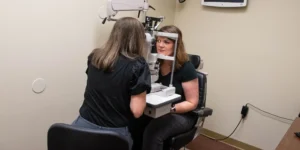
Caring for your family’s vision health is a big responsibility. Fortunately, Hardin Valley Eyecare & Optical provides vision care for patients at every stage of life. From the cradle to your golden years, our team is dedicated to providing the highest quality of care for your whole family.
Men are at higher risk of diabetes and high blood pressure, making routine comprehensive eye exams a must for their vision and general health. Women face unique eye care challenges throughout life, including hormone-related vision problems and a higher risk of migraines.
School vision screenings for kids can be helpful, but they’re no replacement for in-office exams. It’s also important to know what vision changes to expect as you get older.
Men’s Vision Health
Whether you wear prescription eyeglasses, contacts, or nothing at all, it’s important for men to care for their vision. The first step for anyone wanting to protect their vision is to get a comprehensive eye exam. These in-depth exams allow your eye doctor to view the inner structures of your eyes and catch issues before they become major problems.
Comprehensive Eye Exams
Men are half as likely to schedule preventative care as women are. This means they likely need extra reminding to stay on top of caring for their health. This can be especially hard for eye exams if they don’t already wear corrective eyewear such as glasses or contacts. But comprehensive eye exams are about much more than checking your prescription.
You may remember having your eyes checked back in elementary school. While these vision screenings helped catch vision issues that prevented you from seeing the board clearly, they weren’t as medically thorough as comprehensive eye exams. That’s because these advanced tests use eye dilation to catch major vision problems as well as general health issues.
With comprehensive eye exams, your Knoxville eye doctor can detect signs of:
These vision problems are just the tip of the iceberg since there are many more eye conditions that can be detected by comprehensive eye exams. On top of that, they also help us spot signs of underlying health conditions such as diabetes and high blood pressure. We act as partners with your primary healthcare provider to get you the treatment you need as quickly as possible.
Diabetes
Men are more likely to develop type 2 diabetes than women and at lower body weights. For men, this puts even more emphasis on monitoring risk factors such as blood sugar levels and being sedentary.
Diabetes can also impact your eye health. Common vision problems associated with diabetes include:
- Diabetic retinopathy
- Macular edema
- Glaucoma
- Cataracts
Diabetic retinopathy is when the blood vessels in your eyes begin to leak blood and other fluids. While it may not have any symptoms early on, advanced stages involve your body creating abnormal blood vessels to replace those that have been damaged. Macular edema is when your vision becomes distorted or blurry due to the swelling of the retina.
Glaucoma can develop due to the abnormal blood vessels created by diabetic retinopathy increasing pressure within the eye. This is because the new vessels prevent the natural flow of fluid and, as more fluid builds up, so does your eye pressure. Without treatment, this can result in permanent vision loss or even blindness.
While a natural part of aging, diabetes can accelerate the development of cataracts. They generally occur as we age due to the breakdown of proteins with the lens of the eye. This causes the lens to become clouded and impair vision and may require surgery. Diabetes accelerates this process and can require you to receive treatment much sooner than normal.
High Blood Pressure
As with diabetes, men are much more likely to have high blood pressure (hypertension) than women. High blood pressure occurs when the force of blood pushing against the artery walls is too high. This causes the heart to work harder, putting your health at risk.
Without diagnosis and treatment, high blood pressure may lead to:
- Aneurysm
- Heart attack
- Heart disease
- Stroke
Also like diabetes, high blood pressure can have a major impact on your vision. For instance, eyes contain tiny blood vessels so they can receive blood like the rest of your body. These tiny blood vessels can be damaged by high blood pressure, causing them to become narrow, thick, and torn. This can result in vision loss if effective treatment isn’t provided immediately.
You have a variety of ways to check and record your blood pressure. One often overlooked or lesser-known way to do it is with comprehensive eye exams. With these exams, your eye doctor may catch signs of high blood pressure before your primary care doctor. This is done by checking the blood vessels in the eye that may indicate problems sooner than other symptoms.
During a comprehensive exam, your eye doctor will check for:
- Thinning of retinal arteries
- Swelling
- Inflammation
This is done using a slit-lamp microscope and retinal photography. Your eye doctor in Knoxville will use these tools to help stay on top of your heart health, helping to protect your vision and overall health.
To dive deeper into men’s eye health, click here!
Women’s Eye Health
Like men, women face unique challenges when it comes to their eye health. To maintain good eye health, it’s important for women to know that they:
- Can be less likely to seek care
- Are more likely to have hormone-related vision problems
- Face a higher risk of migraines
- Are at a higher risk for age-related eye diseases
- Have easy ways to make better decisions about eye health
1. Less Likely to Seek Care
Similar to men, women can be less likely to seek care depending on their circumstances. For instance, women often act as the primary caregiver in households including making the lion’s share of the healthcare decisions.
This can be great for spouses, children, and aging parents. However, it can often come at the expense of their own well-being. Women should prioritize time for their own health,—including their vision. This will help ensure that they have a better quality of life for years to come.
2. More Likely to Have Hormone-Related Vision Problems

Women are much more likely to experience hormone-related eye problems, especially as they grow older. This is caused by changes in sex-related hormones such as estrogen, which change over the span of your life. Consider dry eye as an example. Women during menopause are more likely to experience the condition due to fluctuating estrogen levels.
Women who are pregnant or menstruating face similar problems. Dry eyes can also be triggered by birth control as well as wearing contact lenses. Experts haven’t determined why this is the case yet. What’s important for women to understand is that they face much higher risks of the condition and should take precautions to ensure their eyes stay moisturized.
Women can experience dry eye for reasons besides female sex hormones. While both sexes create testosterone, it may play a crucial factor in women who develop dry eye. For example, polycystic ovary syndrome (PCOS) can be caused by the hormone, resulting in ovulation issues and cysts on top of an increased risk of dry eye.
3. Higher Risk of Migraines
Migraines are very common with millions of Americans suffering from them. However, women are much more likely to experience them. Migraines are usually associated with severe and debilitating headaches, but sufferers are more likely to experience severe eye pain and sensitivity to light.
Migraine sufferers have also reported seeing “auras” taking the form of:
- Bright spots
- Sparks
- Other visual disturbances
Women are twice as likely as men to experience this phenomenon. There currently isn’t much research on the connection between vision and migraines. On the other hand, those suffering from migraines can receive treatment and make choices that improve their overall wellness. This makes living with migraines much easier, regardless of whether you’re a woman or a man.
4. Higher Risk for Age-Related Eye Diseases
Women tend to have longer lifespans than men on average, putting them at a greater risk for age-related eye diseases. This includes common age-related eye problems such as:
- Cataracts
- Glaucoma
- Age-related macular degeneration
Cataracts
Cataracts are the clouding of the lens due to the breakdown of proteins as we age. They are also one of the most common causes of blindness worldwide, and your risk only goes up as you age. This is because, without treatment, the clouding worsens resulting in reduced vision.
Common cataract symptoms include:
- Dimmer vision
- Glare from lights when driving at night
- Requiring more light to read
Many treatments for cataracts are available. Surgery is usually reserved as a final option once other treatments have stopped working. Cataract surgery has greatly improved over the years and, like LASIK surgery, can improve your distance vision without the need for corrective eyewear.
Glaucoma
Glaucoma is the loss of your peripheral (side) vision due to the optic nerve being damaged by high eye pressure. While it starts with your peripheral vision, the condition can eventually affect your overall vision without treatment.
As with cataracts, glaucoma progresses slowly and doesn’t have any noticeable symptoms besides vision loss. This makes early detection extremely important in order to protect your vision. The best way to do this is with regularly scheduled comprehensive eye exams to make sure that you get the diagnosis and treatment that you need.
Age-Related Macular Degeneration (AMD)
Age-related macular degeneration is the thinning of the macula near the retina. It affects your central (middle) vision, making it difficult to see objects directly in front of you whether near or far. Like cataracts and glaucoma, AMD is a slow-moving disease that doesn’t become apparent until the later stages, making early detection essential.
5. Have Easy Ways to Make Better Decisions About Eye Health
It’s true that women face unique challenges to their eye health. Fortunately, there are plenty of ways to protect the health of your eyes and overall health.
This includes:
- Comprehensive eye exams
- Making healthy food choices
- Managing your weight
- Not smoking
- Learning your family medical history
- Wearing appropriate protective eyewear
As mentioned previously, comprehensive eye exams are an important part of your preventative healthcare regimen. They allow Dr. Travis Thompson and Dr. Catherine Abbott a clear view of your eyes’ inner workings. Making healthy food choices includes eating an omega-3-rich diet that includes fish, citrus, and leafy green vegetables that support your vision.
Nutrition also plays an important role in managing your weight, which can help prevent or control vision-affecting diseases such as diabetes. Not smoking will help reduce your risk of cataracts, glaucoma, and AMD.
Learning your family medical history gives your doctor an idea of what issues to look out for. Wearing appropriate eyewear outdoors or when working can also reduce your risk of cataracts and AMD.
Click here to learn more about how women can protect their eye health!
Children’s Eye Health

Just like fully grown adults, eye exams for children are as important as routine visits to the dentist or pediatrician. Vision screenings at school can certainly help catch vision problems. However, a visit to the optometrist is the best way for them to get an in-depth exam that covers a variety of eye conditions.
Some of the most common eye problems for children include:
- Amblyopia
- Strabismus
- Myopia
- Hyperopia
- Astigmatism
Amblyopia (lazy eye) may seem like a minor problem. What some may not realize is that it actually indicates poor vision. Without treatment, kids may experience impaired vision or even vision loss. Strabismus (crossed eyes) is when eyes don’t point in the same direction due to misalignment. Treatment with an eye patch can help the affected eye grow stronger.
Myopia, hyperopia, and astigmatism are all refractive errors that affect vision in different ways. For instance, myopia (nearsightedness) makes it hard to see far-away objects. Hyperopia (farsightedness) makes it difficult to make out up-close objects. Astigmatism occurs when the eye’s surface is abnormally curved, making it more difficult for your child to see.
Vision Care for Children in Knoxville, TN
Hardin Valley Eyecare & Optical has been providing the highest quality of care to children and their families since 2009. We proudly serve Hardin Valley as well as the surrounding Knoxville community, treating a wide variety of:
- Eye problems
- Eye injuries
- Eye diseases
Dr. Travis Thompson, Dr. Catherine Abbott, and the rest of our team work together to provide the best care possible for your child or teen. We do this by using the latest diagnostic tools and offering eyeglass frames from the most popular brands including Ray-Ban and Kate Spade. We also offer a wide range of contacts, including daily contact lenses, for going frames-free.
To learn more about supporting your child’s vision, click here!
Common Eye Problems as You Age
Changes in vision are unavoidable as you grow older. Some can’t be helped, but they can be caught early with comprehensive eye exams. This ensures that you get the treatment you need so you can continue enjoying clear and sharp vision as you get older. Two common eye problems are presbyopia along with eye floaters and flashes.
Presbyopia
Presbyopia is a condition that makes it hard to see up-close objects. It is caused by the lens becoming less flexible as you get older, making it harder for it and the cornea to reflect light. Presbyopia develops gradually over time, making it difficult to notice in the early stages. You may notice yourself holding your phone or books further away to see more clearly.
Presbyopia usually sets in during people’s early- to mid-40s, although it can develop earlier in certain cases (premature presbyopia). This includes having conditions such as:
- Farsightedness
- Multiple sclerosis
- Diabetes
- Cardiovascular disease
In some cases, premature presbyopia can also be caused by certain medications. This can include diuretics, antidepressants, and antihistamines. Talk to your doctor to see if premature presbyopia may be a side effect of any medicines that you are taking.
Click here to learn more about common eye problems as you get older!
Eye Floaters and Flashes
Most people have experienced floating specks and possibly even flashes of light in their field of vision. These are known as:
- Eye floaters
- Eye flashes
Eye floaters are the result of clumps or strands of tissue forming in the fluid of your eye (vitreous gel). They act as a barrier between the light that enters your eye and your retina, creating shadows that we perceive as “floaters.”
They often appear as:
- Circles
- Cobwebs
- Lines
- Specks
You’re most likely to notice them when looking at a plain background such as a white wall or a blue sky.
Eye flashes are a result of the eye fluid changing in some way, such as shrinking. This pulls on the retina and separates it from the fluid, resulting in “seeing stars” in your field of vision. In some instances, they can appear off and on over a period of several weeks.
Flashes and floaters can be a cause for alarm. They become more common as we grow older because the fluid in our eyes begins to thicken or shrink, resulting in more of the clumping and pulling that causes them. There are cases where a sudden increase may indicate a retinal tear or detachment. It’s important to seek immediate medical attention in these rare instances.
Do you need to schedule eye exams for your family? Contact us today to schedule their appointments!
Comprehensive eye exams are essential for men since they are at higher risk of developing diabetes and high blood pressure. Women have unique vision concerns throughout their life, making eye care a priority. In-office eye exams can provide more insight into their vision than school vision screenings. Older adults experience unique eye changes they should be aware of.
Hardin Valley Eyecare & Optical has been serving Knoxville since 2009. Located at 10904 Spring Bluff Way, you can schedule an appointment online or give us a call at (865) 888-0892.






